From Tamba Sasayama to Edo
More of
Tamba-guro
Black Soybeans!
A Story about Beans


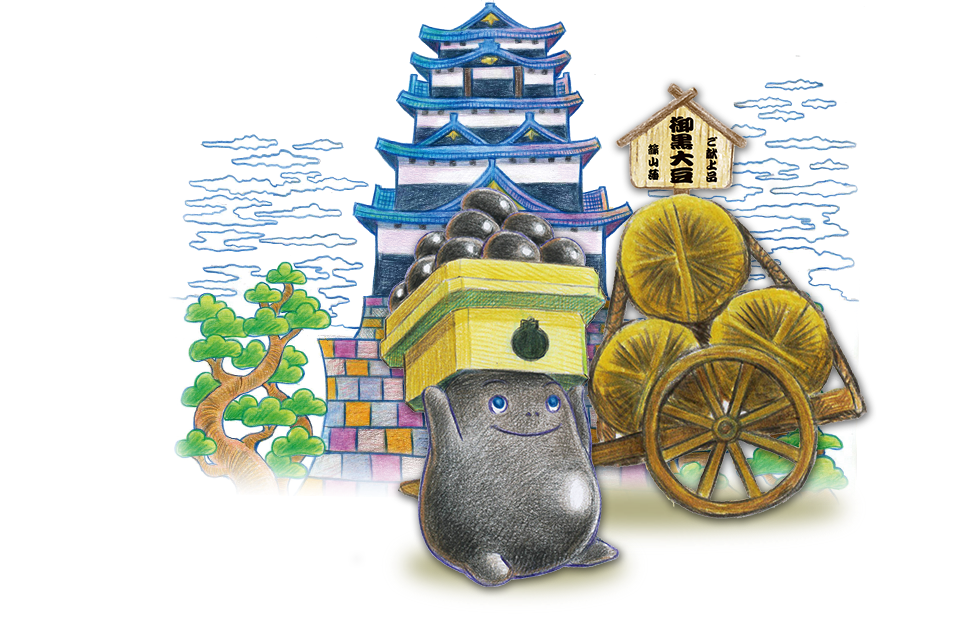
Tamba-guro black soybeans born in Tamba Sasayama.
What kind of history do these black soybeans that are particularly large and have a good
aroma have?
They have always been highly valued and loved.
We would like to demonstrate the progress.
Editorial Supervisor / Sakuo Shimahara


Since ancient times,
black soybeans
have been said to be healthy
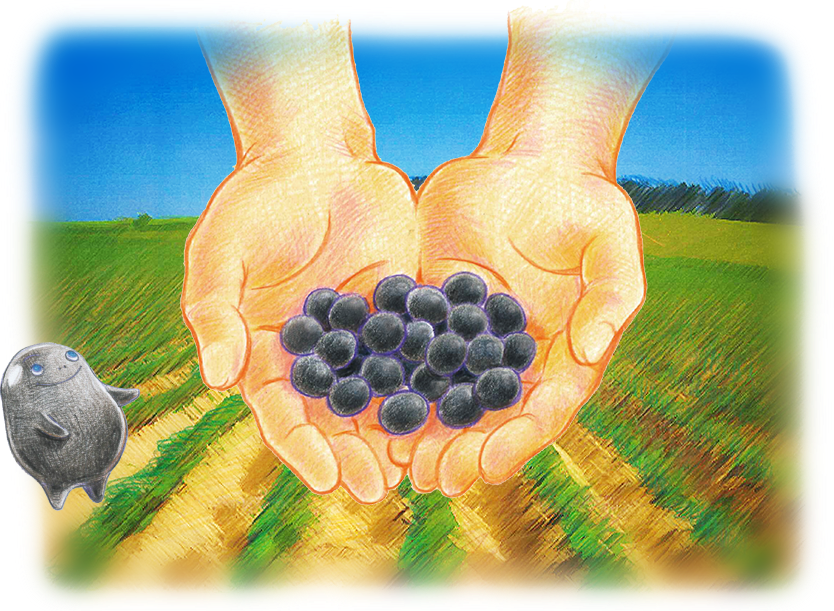
The benefits of black soybeans recorded in old writings
Black soybeans, a type of soybean, have been used not only as food but also
as a raw material for medicine since ancient times.
Black soybeans have been used as herbal medicine in China for thousands of
years, and the oldest Chinese medicine book, the Shennong Book of Herbal
Medicine, which is said to have been written around 2,000 years ago, reads
that black soybeans have “live blood” (to improve blood circulation), “water
utilization” (to adjust abnormal water distribution), “relief” (to get rid
of colds), and detoxification (to eliminate the effects of poison that has
entered the body) as the benefits.
It is not well known when black soybeans were introduced to Japan,
but black soybeans from Kawachi Province appear in the Engi Shiki, a
legal code created in the 10th century during the mid-Heian period.
In the dictionary Wamyo Ruijusho, which was created during the same
period, black soybeans are listed as kuro-mame (black beans), and
they have been popular since ancient times.
Honzo-Komoku (1596), which had a great influence on Japanese
pharmacology, describes the names, production areas, medicinal
effects, and prescription examples of approximately 1,900 species of
animals, plants, and minerals.
This book states, “Soybeans come in several colors: black, white,
yellow, brown, blue, and mottled, but only the black ones are used
as medicine,” and “Black soybeans are effective for kidney disease.
It has the effect of improving blood flow, regulating urination,
calming moods, removing colds, and eliminating all poisons."
In an effort to spread knowledge of “Honzo-Komoku” to the general
public, many Honzo-Moku (a book specializing in knowledge about
Chinese medicine) began to be published during the Edo period. The
examples are “Honcho Shokkan'' (1697) by Hitomi Hitsudai, which
explains the foods used in the daily lives of common people,
includes the author's own experiences, and “Honzo-Komoku
Enlightenment'' (1803-06) by Ono Ranzan, which is considered as the
great culmination of “Honzo-Komoku''.
In other words, in the world of Chinese medicine, black soybeans are
said to have the effect of supporting excellent kidney function
(particularly the effect of improving blood flow). In fact, clinical
cases have been reported in which drinking black soybean broth
improved blood flow and improved high blood pressure and angina
pectoris. Recent research has revealed that polyphenols, which are
abundantly contained in the seed coat of black soybeans, are the
main source of medicinal effects.
more
Black soybeans were the main ingredient
in emergency food for Samurai
and Ninjas
Once the samurai and ninja of the Sengoku period entered the battlefield,
they were often deprived of sustenance, and it was not uncommon for them to
be unable to find enough food. In case of such situations, there was a
portable food called “Hyoro-gan''.
The Art of War of the Uesugi Family explains how to make “Hyoro-gan, stating
“Powder hemp seeds and black soybeans, mix them with buckwheat flour, soak
them in sake, dry them in the sun, soak them in sake again, make pills, and
steam them.” The emphasis was particularly placed on black soybeans. It is
said that having 1 to 3 pills of Hyoro-gan was equivalent to one meal, and
that eating that two or three times a day would prevent starvation.
Convenient to carry, easy to store, and highly nutritious, Hyoro-gan was used not only to get rid of hunger, but also to maintain physical strength through nutrition. Black soybeans, which have long been known to be healthy, were one of the ingredients for Hyoro-gan.
more
Healthy foods eaten
by General Tokugawa Yoshinobu
There are records that Tokugawa Yoshinobu (1837-1913) used to eat black
soybeans.
In a letter from his father, Tokugawa Nariaki, written to Tokugawa
Yoshinobu, the last General of the Edo shogunate, there is a passage in
which the father tells him to eat black soybeans.
“Eat 100 black soybeans a day, and drink milk as well. I hope that you
continue this for the rest of your life,'' Nariaki instructed, in order to
live a long life as a general.
Well, did Yoshinobu follow his father's instructions?
“Since that day, I've been drinking milk every day, and I've been
eating black soybeans in the morning, so please rest assured.''
This indicates that he followed the instructions given by his
father. You can imagine Nariaki's relieved expression.
This letter was written in 1854 (Ansei 1), at the end of the Edo
period. In 1866 (Keio 2), Prince Yoshinobu became the 15th Tokugawa
shogun. In 1867 (Keio 3), the Edo Shogunate was brought to an end
with the restoration of power (return of power from the Shogunate to
the Imperial Court, Emperor). After resigning from his post as
shogun, he spent the rest of his life pursuing various hobbies such
as photography and hunting, and he passed away in 1913 (Taisho 2) at
the age of 76.
more
“Tamba-guro black soybeans”
born from harsh nature
and
people’s wisdom
Community ingenuity to overcome water shortage
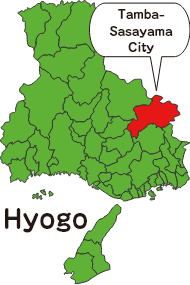
Taki-gun (currently Tamba-Sasayama City) has an inland climate, with a
big difference in high day and night temperatures as well as summer and
winter temperatures, little precipitation, and it is not blessed with
large rivers. As the surrounding mountains are low, and the area that
collects water is very small, it has suffered from a lack of
agricultural water.
Many reservoirs were built in mountain valleys from the beginning of the
Edo period, but most of the ponds were small in size and only stored
water from mountain valleys or rainwater, so even during the
rice-planting season, enough water did not reach the flat part of
downstream basin.
Therefore, the people of the villages living in the downstream area
held discussions in their villages to prevent a situation where if
they planted rice in all the rice fields, there would not be enough
water and they would not be able to harvest rice from any of the
rice paddies, and as a result, a sacrificial field was established.
Sacrificial rice fields are rice fields that do not receive water or
grow rice.
The people used their ingenuity to create a technique to dig up the
soil from the sacrificial fields and make it into high ridges to
grow black soybeans. It was invented about 300 years ago.
more
Production method throughout the community
Cultivating black soybeans takes a lot of time and effort. Locally, it is also called “Kuro Mame'' (burden beans). That is because it is very difficult to cultivate and takes six times as long as rice cultivation. First of all, the former rice fields must be converted into well-drained fields. Tamba Sasayama is a region that suffers from water shortages, but the soil is clay heavy and there are many wet rice fields that tend to have drainage stagnation. To grow black soybeans, the soil in the paddy field must be dug up and raised into high furrows.
High ridges were formed in early June. The real process of making black soybeans is finally beginning. Sowing seeds, transplanting seedlings, gathering soil at the base of the plant, fertilizing, weeding, controlling pests and diseases, roping to prevent falling, watering, removing leaves, mowing, sorting wrinkled and insect-eaten grains, soil preparation, etc., the labor-intensive work that would feel endless continues from June to December. However, the people of the community had a deep-rooted sense of “cooperation'' in which the heavy agricultural work was carried out by the entire community. Black soybean cultivation has been organized in each community and passed down through generations.
more
Protecting the nature and creatures of the natural rural area
through black soybean cultivation
Black soybeans are a crop that tends to suffer from repeated cropping problems, such as poor growth and low yields if planted in the same paddy field year after year. In Tamba Sasayama, a field rotation method has been adopted in which black soybeans are grown and then paddy rice is planted for two to three years, in an effort to improve the soil. In the past, ash fertilizer made by burnt fallen leaves and dead trees was used as a soil conditioner.
The plants used for ash fertilizer were also harvested by
“wachi-gari''. Wachi-gari is the process of collecting plants and
fallen leaves from the boundary between farmland and rural natural
area. Not only did it prevent the farmland from being shaded by the
sun, but it also helped protect the nature and landscape of the
natural area.
In addition, the ponds built to secure water for agricultural use
are home to amphibians such as the Japanese salamander and green
tree frog, as well as aquatic insects such as the long-eared beetle.
Rare creatures in danger of extinction coexist with agriculture in
Tamba Sasayama.
more
Cultivation of the excellent variety, “Tamba-guro”
Various types of black soybeans existed in Tamba Sasayama. In order to
produce large black beans with high value, farmers have selected large black
soybeans every year or exchanged seeds among themselves and sowed and
cultivated them.
In 1941, the Hyogo Prefectural Agricultural Experiment Station (currently
the Hyogo Prefectural Agriculture, Forestry and Fisheries Technology Center)
developed the “Habe-guro'' strain from the Tamba Sasayama black soybeans
that had been passed down through generations. After comparison,
"Tamba-guro" was selected and designated as the recommended variety by Hyogo
Prefecture.
Certified as a Japanese agricultural heritage
Black soybeans have been cultivated in Tamba Sasayama for about 300
years.
In February 2021 (Reiwa 3), "Tamba Sasayama's black soybean cultivation -
excellent seeds and family farming supported by the villages" was certified
as a Japanese agricultural heritage.
The following is an excerpt from “Tamba Sasayama Agricultural Heritage,
Connecting Black Soybeans to the Future'' (produced by Tamba Sasayama City,
2023).
Let's take a look at the history of black soybeans
Black soybean cultivation was born out of hard work and ingenuity in Tamba Sasayama, where there is little rain. It has a unique “Kanden Takaune cultivation technique'' and “ash hut'', a recycling-oriented and highly sustainable system.
Selective breeding of black soybeans continued since the Edo period
Breeding has continued since the Edo period, and today's delicious black soybeans have been created by carefully selected varieties from among many.
What if they hadn't employed these exceptional techniques?
Tamba Sasayama has become a town that has attracted attention from all over the country, not only because of its black soybeans, but because it has carefully preserved its lifestyle and culture.
Tamba Sasayama's various initiatives
Tamba Sasayama, which was built through the efforts of people over the past 300 years, will continue to take various initiatives to build a better town such as “Mahoroba Canal in Agricultural Capital'', “Megumi Rice of Agricultural Capital'', “A Future City with an Exciting Environment'', and “Animal Infestation Countermeasures'' from the perspective of regional revitalization.
more
※Japanese Agricultural Heritage is a certification system to recognize regions that operate traditional agricultural, forestry and fisheries (its industrial system) that should be passed onto the next generations by based on Japan's own certification standards, similar to the Food and Agriculture Organization of the United Nations (FAO) certifying world agricultural heritages.


“Tamba-guro black soybeans”
from Tamba Sasayama that
have been loved for a long time
Black soybeans from Tamba Sasayama
Kawakita Village praised
by the feudal lord
There used to be a village called Kawakita Village in Taki District. Every year, this village created sacrificial rice fields that they didn’t plant rice, and the area was large. Black soybeans were planted in the sacrificial fields.
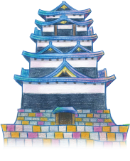
According to the Taki-gunshi (1911), around 1750 in the
middle of the Edo period, the lord of Sasayama praised
the black soybeans of Kawakita village as being
particularly superior among the agricultural products in
Taki-gun, and he dedicated the selected black soybeans
harvested in Kawakita village to the shogunate.
Unfortunately, there is no mention of the source in this
book, and the dedication cannot be confirmed in the
original source.
In the book written in the late Edo period, "Taki-gun
Meisaiki" (1848-54), there is a description of "Even if
the black soybeans produced in Kawakita get boiled well,
their skin doesn’t crack" and even now it is famous as
Kawakita black soybean.
more
Tamba Sasayama, the place to go for black soybeans
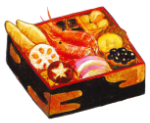
The earliest record of black soybeans from Tamba Sasayama is from the cookbook “Ryori (Cooking) Momoku Chomisho'' published in 1730 (Kyoho 15), stating “Zazen beans, boiled black soybeans, are a specialty of Tanshu Sasayama, where they are boiled hard, then wiped with a cloth and simmered in a sauce over charcoal,” and “Black soybeans from Tanshu Sasayama are excellent. Soak them in the boiling sauce.”
In other words, Zazen beans, which are black beans hard
boiled in a sauce, are a specialty of Tanshu Sasayama,
and the black beans from Tanshu Sasayama are excellent.
The beans must be boiled well until the liquid has
soaked through. Zazen beans from Tamba Sasayama had
already become a specialty in the mid-Edo period.
Additionally, in “Tamba no Kuni Oezu” (1799), which
describes the entire area of Tamba Province, there is
mention of “black soybeans”, a specialty of Tamba
Province.
“Kiyu Shoran” (1830), a collection of essays that
describes the customs of the late Edo period, states,
“in ‘Chomi-sho”, it says black soybeans from Tanshu
Sasayama are excellent. The pressed soup is for simmered
dyes’ (It has become a custom to cook black soybeans in
the new year time)'', which shows that simmered black
soybeans was a standard New Year's dish even back then.
more
Black soybean as seasonal offering
During the Edo era, there was a custom of seasonal offering
between the shogunate and feudal lords. That is the act of
presenting seasonal produce from the territory to the
shogunate.
In 1831 (Tenpo 2), the feudal lord Tadayasu Aoyama had Habe
Rokubei of Hioki Village distribute good black soybean seeds
to the farmers of the village in order to improve the
quality.
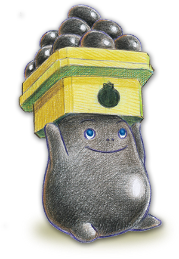
This probably helped them harvest a lot of high-quality
black soybeans. The lord of the Sasayama domain
presented black soybeans to the shogunate in 1846 (Koka
3) and 1856 (Ansei 3). The season is mid-winter, which
in the current calendar, is from the beginning of
January to the beginning of February.
This can be confirmed in “Honka Bukan” and “Ansei
Bukan.'' Bukan is a list of feudal lords, Hatamoto, and
Shogunate officials from the Edo period.
The offerings were the only official products of the
countries at the time. As a result of this offering
system, Sasayama's black soybeans were certified as
officially recognized by the Shogunate, and they became
a product that people trusted as being of excellent
quality.
more
Why Tamba-guro black soybeans are loved
Black soybeans not only contain the nutrients contained in soybeans such as high-quality protein, fat, dietary fiber, calcium, iron, vitamins, and soy isoflavones, but also contain a type of polyphenol called anthocyanin in the black seed coat.
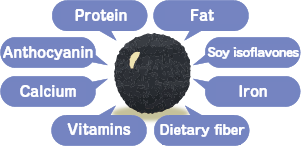
Polyphenols have antioxidant effects and work to remove
active oxygen, which is said to cause disease and
aging.
Among black soybeans, Tamba-guro black soybeans are a
first-class black soybean that is used in New Year's
dishes. It has one of the largest grains in the world,
its skin doesn't crack easily even when boiled, it
absorbs water well, and it has a very beautiful
shape.
Tamba-guro black soybeans have another characteristic
that confirms their reliable quality. There is white
powder called bloom (wax powder) on the surface of the
seed coat. Bloom is produced by black soybeans
themselves and is said to prevent infection with
pathogens and maintaining freshness.
When boiled, beans have a soft and chewy texture, and
their sweet aroma and particular flavor that fills the
mouth have fascinated people since the Edo period.
more
The history of black soybeans in Tamba Sasayama
-
Kyoho 15

(1730) -
“Cooking (Ryori) Momoku Chomi sho” includes sentences such as “Zazen beans (Mame), which are well boiled, then wiped with a cloth and cooked over charcoal in a sauce, are a specialty of Tanshu Sasayama,” and “Black beans are pressed, boiled in soup, and dyed.''
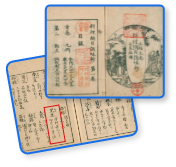
The section of “Black soybeans from
Tanshu Sasayama are excellent”
in “Ryori Momoku Chomi sho”
Source: National Diet Library Digital Collection
-
Kansei 11

(1799) -
In “Tamba no Kuni Oezu'', there is a mention of “black soybeans, a specialty of Tamba”.
-
Bunsei 1
(1818) -
The wealthy farmer Sonoda Sho Juzaemon proposes a plan to domestically produce black soybeans to his domain.
Black soybean production in Taki District (currently Tamba Sasayama City) is approximately 300 koku (approximately 45 tons)
-
Kohka 3
(1846) -
The Sasayama feudal lord presented black soybeans to the Edo shogunate.
-
Kaei period
(1848~54) -
In "Taki -gun Meisai-ki", it is written that "Black soybeans produced in Kawakita don’t crack even when boiled well."
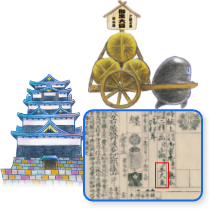
The Section of “Seasonal offering
of Black soybeans” in “Koka Bukan”
Source: National Diet Library Digital Collection
-
Ansei 3
(1856) -
The Sasayama feudal lord presented black soybeans to the Edo shogunate.
-
Meiji 4
(1871) -
Motojiro Habe selects the excellent strain “Habeguro''
-
Meiji 23

(1890) -
Honjiro Habe exhibited his product as "Soybean Black" at the 3rd National Industrial Exhibition and received the "Third Prize of Merit".
-
Meiji 28
(1895) -
Honjiro Habe exhibited his soybeans as “Habeguro” at the 4th National Industrial Exhibition, received the “Second Prize of Merit” and was purchased by the Ministry of the Imperial Household.
- Early Showa era
-
Black soybean production in Taki District is approximately 200 koku (approximately 30 tons)
-
Showa 9
(1934) -
The two brands of “Kawakita Kuro Soybean” and “Habekuro” in Taki District were unified into “Tamba-guro Soybean.”
-
Showa 16
(1941) -
Cpmpared with “Habeguro'', “Tambaguro” was designated as a recommended variety by Hyogo Prefecture.
-
Showa 28
(1953) -
Production volume of Tamba-guro soybeans in Taki District is approximately 100 koku (approximately 15 tons)
-
Showa 29
(1954) -
Odagaki Shoten registers “Big Tamba soybean” as a trademark
-
Showa 46
(1971) -
Full-scale production of black soybeans begins in paddy fields in Taki District due to acreage reduction policy
-
Showa 53
(1978) -
Fujikko Co., Ltd. starts selling Tamba-guro black soybeans in the “Omame-san” series
-
Showa 59
(1984) -
Odagaki Shoten commercializes Tamba-guro soybean edamame for the first time
-
Showa 62
(1987) -
Odagaki Shoten Co., Ltd. registers Tamba-guro edamame “Tamba no Kurosaya” as a trademark
-
Heisei 1

(1989) -
Hyogo Prefecture cultivates a large, superior strain “Hyokei Kuro No. 3”
-
Heisei 20
(2008) -
Hyogo Prefecture Tamba-guro Promotion Council is established.
-
Heisei 23
(2011) -
Tamba Sasayama Agricultural Cooperative Association acquires regional collective trademark “Tamba Sasayama Black Soybean”
-
Reiwa 3
(2021) -
"Tamba Sasayama black soybean cultivation" is recognized as a Japanese agricultural heritage.
Tamba black soybean production in Tamba Sasayama City is 437 tons, with a national share of approximately 20%

open
Tamba-guro black soybeans have been carefully cultivated over the past 300 years in the harsh environment and with the wisdom of people. We hope that the large, beautiful, delicious, healthy, and high-quality Tamba-guro black beans will continue to be cherished and cultivated in Tamba Sasayama. We will continue to support the community.


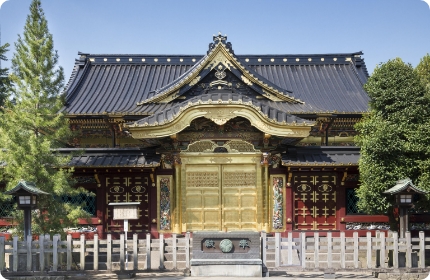
To Ueno Toshogu from Tamba Sasayama
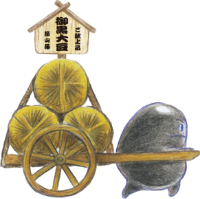
Black soybean offering ceremony held in Reiwa 5 at Ueno Toshogu Shrine

